Chelicerata - Study guides, Class notes & Summaries
Looking for the best study guides, study notes and summaries about Chelicerata? On this page you'll find 34 study documents about Chelicerata.
All 34 results
Sort by
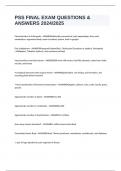
-
PSS FINAL EXAM QUESTIONS & ANSWERS 2024/2025
- Exam (elaborations) • 8 pages • 2024
- Available in package deal
-
- $8.49
- + learn more
PSS FINAL EXAM QUESTIONS & ANSWERS 2024/2025 Characteristics of Arthropods - ANSWERSbilaterally symmetrical, joint appendages, they molt, exoskeleton, segmented body, open circulatory system, brain is ganglia Five Subphylums - ANSWERSHexapoda (butterflies), Chelicerata (Scorpions or spiders), Myriapoda ( Millipedes), Trilobites (extinct), and crustacea (shrimp) Insect products used by humans - ANSWERSSilk from silk worms, food like almonds, made from chitin, red dye, and honey 4 ec...
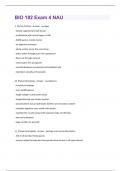
-
BIO 182 Exam 4 NAU QUESTIONS & ANSWERS RATED 100% CORRECT!!
- Exam (elaborations) • 15 pages • 2024
- Available in package deal
-
- $7.99
- + learn more
1. Phylum Porifera - Answer-- sponges - loosely organized and lack tissues - multicellular with several types of cells - 8,000 species, mostly marine - no apparent symmetry - adults sessile, larvae free-swimming - water drawn through pores into spongocoel - flows out through osculum - choanocytes line spongocoel - mesohyl between choanocytes and epithelial cells - reproduce sexually and asexually 10. Phylum Nematoda - Answer-- roundwomrs - in nearly all habitats - over 20,000 specie...
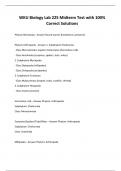
-
WKU Biology Lab 225 Midterm Test with 100% Correct Solutions
- Exam (elaborations) • 5 pages • 2024
-
- $11.49
- + learn more
Phylum Nematoda - Answer Round worms (hookworm, pinworm) Phylum Arthropoda - Answer 1. Subphylum Chelicerata - Class Merostomata: aquatic chelicerates (horseshoe crab) - Class Arachnida (scorpions, spiders, ticks, mites) 2. Subphylum Myriapoda - Class Diplopoda (millipedes) - Class Chilopoda (centipedes) 3. Subphylum Crustacea - Class Malacostraca (isopod, crabs, crayfish, shrimp) 4. Subphylum Hexapoda - Class Insecta (insects)
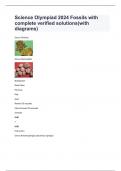
-
Science Olympiad 2024 Fossils with complete verified solutions(with diagrams).
- Exam (elaborations) • 24 pages • 2024
-
- $18.49
- + learn more
Genus Triticites Genus Nummulites Brainpower Read More Previous Play Next Rewind 10 seconds Move forward 10 seconds Unmute 0:00 / 0:00 Full screen Genus Astraeospongia (calcareous sponge) Genus Hydnoceras (glass sponge) Genus Archimedes Genus Rhombopora Order Dendroidea (benthic graptolites) Order Graptoloidea (planktic graptolites) Genus Favosites Genus Halysites Genus Heliophyllum (horn coral) Genus Hexa...
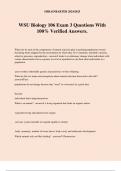
-
WSU Biology 106 Exam 3 Questions With 100% Verified Answers.
- Exam (elaborations) • 11 pages • 2024
- Available in package deal
-
- $10.49
- + learn more
WSU Biology 106 Exam 3 Questions With 100% Verified Answers. What role do each of the components of natural selection play in pushing populations toward becoming better adapted for the environment in which they live? (mutation, heritable variation, selective pressures, reproduction) - answer-leads to evolutionary change when individuals with certain characteristics have a greater survival or reproductive rate than other individuals in a population -pass on these inheritable genetic charac...
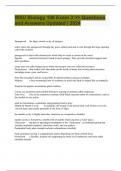
-
WSU Biology 106 Exam 3 >> Questions and Answers Updated | 2024
- Exam (elaborations) • 14 pages • 2024
- Available in package deal
-
- $12.49
- + learn more
WSU Biology 106 Exam 3 >> Questions and Answers Updated | 2024 Spongocoel the large central cavity of sponges. water enters the spongocoel through tiny pores called ostia and it exits through the large opening called the osculum. spongocoel is lined with choanocytes which help to create a current in the water. Spicule structural elements found in most sponges. They provide structural support and deter predators. Large ones are called megascleres while microscopic ones...
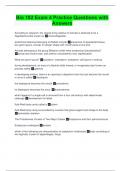
-
Bio 182 Exam 4 Practice Questions with Answers
- Exam (elaborations) • 5 pages • 2024
- Available in package deal
-
- $8.99
- + learn more
According to research, the closest living relative of animals is believed to be a flagellated protist known as choanoflagellate. anatomical features belonging to Radata include presences of specialized tissue, two germ layers, circular or tubular shape with mouth parts at one end Animals belonging to the group Bilateria exhibit what anatomical characteristics? dorsal and ventral side, and anterior and posterior end, cephalization What are germ layers? ectoderm, mesoderm, endoderm: cell ...
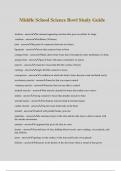
-
Middle School Science Bowl Study Guide
- Exam (elaborations) • 7 pages • 2024
- Available in package deal
-
- $11.49
- + learn more
Middle School Science Bowl Study Guide skeleton - answerthe internal supporting structure that gives an artifact its shape vertebrae - answerbackbone (26 bones) joint - answerthe point of connection between two bones ligaments - answertissue that connects bone to bone compact bone - answerHard, dense bone tissue that is beneath the outer membrane of a bone. spongy bone - answerpart of bone with many small pores or spaces marrow - answerconnective tissue that fills the cavities of bones c...
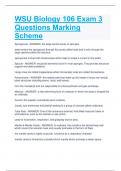
-
WSU Biology 106 Exam 3 Questions Marking Scheme
- Exam (elaborations) • 18 pages • 2023
-
- $13.49
- + learn more
WSU Biology 106 Exam 3 Questions Marking Scheme Spongocoel - ANSWER- the large central cavity of sponges. water enters the spongocoel through tiny pores called ostia and it exits through the large opening called the osculum. spongocoel is lined with choanocytes which help to create a current in the water. Spicule - ANSWER- structural elements found in most sponges. They provide structural support and deter predators. Large ones are called megascleres while microscopic ones are calle...
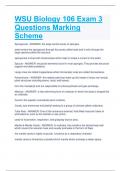
-
WSU Biology 106 Exam 3 Questions Marking Scheme
- Exam (elaborations) • 18 pages • 2023
- Available in package deal
-
- $13.99
- + learn more
WSU Biology 106 Exam 3 Questions Marking Scheme Spongocoel - ANSWER- the large central cavity of sponges. water enters the spongocoel through tiny pores called ostia and it exits through the large opening called the osculum. spongocoel is lined with choanocytes which help to create a current in the water. Spicule - ANSWER- structural elements found in most sponges. They provide structural support and deter predators. Large ones are called megascleres while microscopic ones are calle...

$6.50 for your textbook summary multiplied by 100 fellow students... Do the math: that's a lot of money! Don't be a thief of your own wallet and start uploading yours now. Discover all about earning on Stuvia


